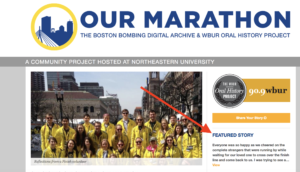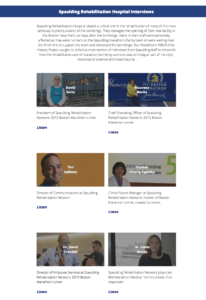Our Marathon 1.0 launched in 2013 in the aftermath of the Boston Marathon bombings as a crowdsourced digital archive aimed at healing and remembrance. It launched on Omeka, an open-source content management system, which allowed for the original team to gather digital items, collect crowdsourced contributions, and build digital exhibits. Our Marathon was rebuilt in 2017-2018 using CERES: Exhibit Toolkit. This new home for Our Marathon 2.0 allowed for both the long-term preservation of the items as well as a new and fresh look for years to come. As part of the Site Migration and Relaunch Team, I had the pleasure of working on the redesign of the public facing site.
As a public history student at Northeastern and a research assistant at the DSG, one of the main goals in redeveloping Our Marathon using CERES: Exhibit Toolkit was to present the information in both an aesthetically pleasing manner and in a way that people would fully understand. For me, that quest began with an in-depth inventory of the Our Marathon 1.0 website. I examined the Omeka site, asking questions like: What did this site do well?, What needed to be changed for the CERES site?, What could be transferred over to the new platform? It was through answering these questions that I had a better understanding of what exactly needed to be done and what we were striving for. In hindsight, this inventory guided me throughout the rest of my work with CERES. Below is in no way a comprehensive answer to either question, but rather some of the major reflections I took away from working on this project.
What did Omeka as a platform do well for Our Marathon 1.0?
- One of the first pieces that immediately caught my eye was the “Featured Story” widget prominently displayed on the homepage. I often found myself clicking to read through the stories that had been submitted. It gets users interested in the collection before one even goes in to look at it. Unfortunately, this is not yet an option in CERES, but is a nice way to grab the attention of an audience.
Featured Story on Our Marathon 1.0
- Our Marathon 1.0 provided a lot of information on the featured collections (Boston City Archives Collections and the WBUR Oral History Project). It provided insight on the provenance of the collection, the major partnerships created throughout the community, and the stories themselves. This information proved invaluable when trying to understand the magnitude of the collection as well as developing pages on CERES for the featured collections.
What needed to be changed in order to create a better user experience on Our Marathon 2.0?
- Usability on the Our Marathon 1.0 website led to a lot of clicking in order to find what one is looking for. More succinct nesting and less clicking to find a certain object was a main goal in developing some of the pages on Our Marathon 2.0.
- Our Marathon 1.0 prominently featured the two collections from the Boston City Archives and the WBUR Oral History Project through built out pages. Given the rate at which new items and stories were being added to the Omeka site, it was understandable that the not all of the collections could be built out to such extent at that time. When developing Our Marathon 2.0, we gave each collection its own description and understanding of where it came from.
- I spent a lot of time working with the WBUR Oral History collection. Out of all the collections, this was the one I spent the most time considering how to organize the page in a way that was more user friendly. The 1.0 version had a list of names linked to the audio files. When working on the new version, I included a photo of those being interviewed as well as their story as it relates to the Boston Marathon bombing. Those stories show that a whole range of people were affected by the tragic event and each of their stories are just as important as the next.
Our Marathon 1.0 Our Marathon 2.0
Given the urgency to develop Our Marathon 1.0 as a platform for remembrance and healing, Omeka served as a great platform to collect and store lots of information. At the time, Omeka was the best platform to serve a crowdsourced archive, something other platforms do not present as an option. However, now that Our Marathon has shifted into an archival collection, CERES allows users to better explore the collection as a whole. It offers a more user-friendly outlet to explore the collection in its entirety, but also uses more of the collection as visual aids, prompting engagement with the material. Omeka was great for 2013 and CERES was great for 2018, but who knows, another five years from now, another public history student like myself could look back on it and see it as outdated.
Looking back on this entire process and being part of such a large team, I gained an appreciation for the collaborative efforts that go into an interdisciplinary project. Many hands were involved in the project from the beginning, and I will always appreciate this opportunity and the many skills I’ve gained through my experience working with Our Marathon.



